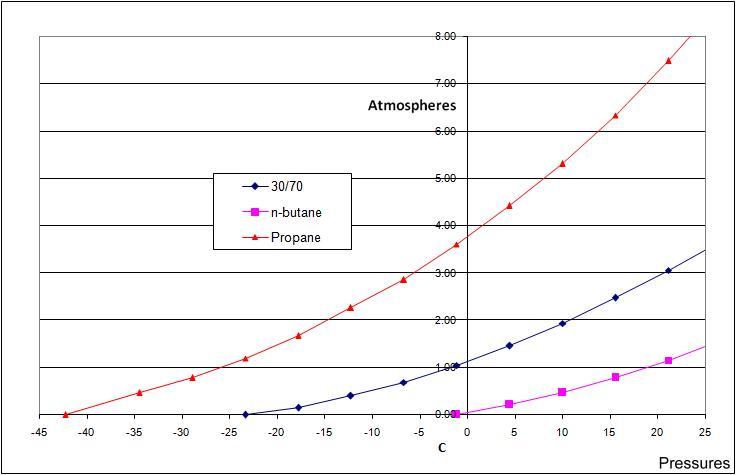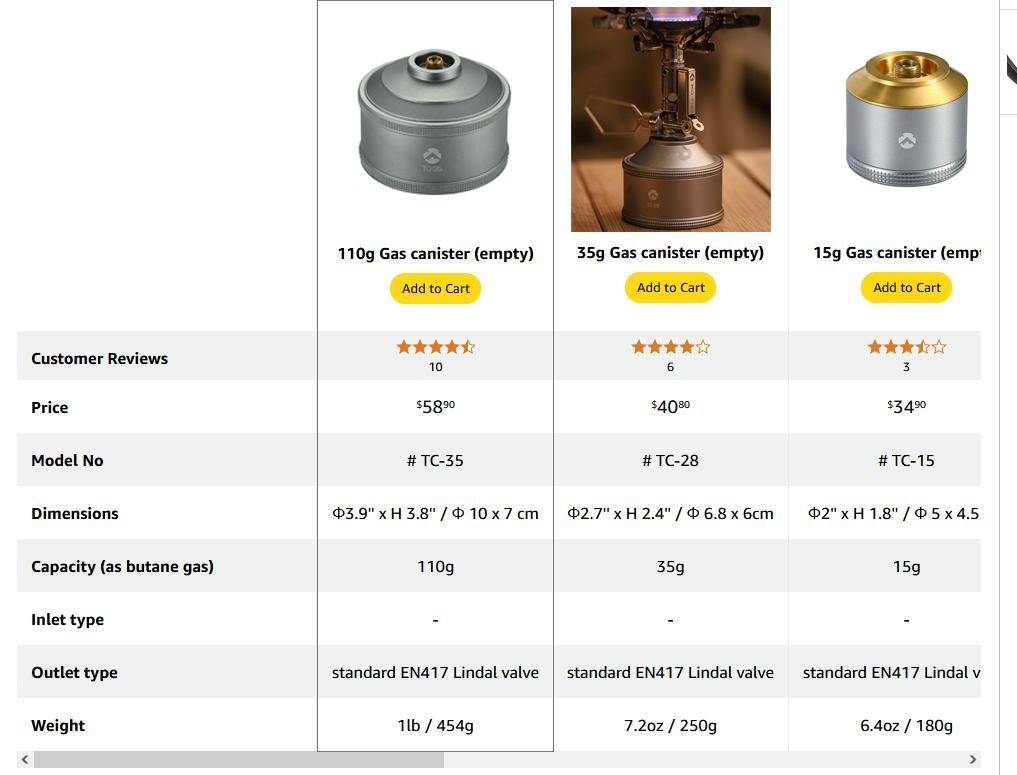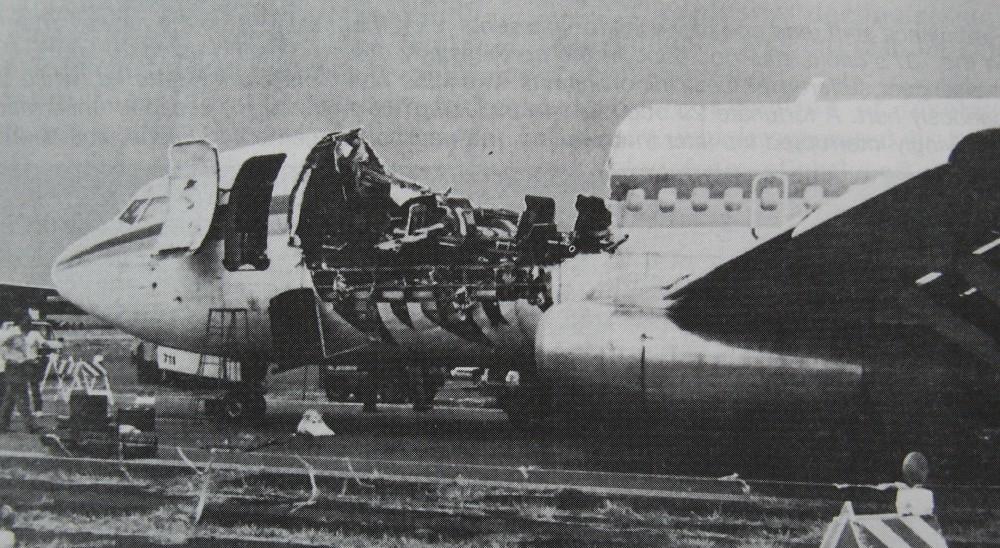Topic
Is it safe to use a FlipFuel to keep refilling a 4oz fuel canister?
Forum Posting
A Membership is required to post in the forums. Login or become a member to post in the member forums!
Home › Forums › Gear Forums › Gear (General) › Is it safe to use a FlipFuel to keep refilling a 4oz fuel canister?
- This topic has 73 replies, 20 voices, and was last updated 5 months, 2 weeks ago by
 Jerry Adams.
Jerry Adams.
-
AuthorPosts
-
Aug 26, 2024 at 10:17 am #3817009
@Mart, thank you. That is very helpful. Now I have to decide which device to get.
Aug 26, 2024 at 11:11 am #3817012Before the U.S. started doing a swap out for empty/full propane tanks, people used any and all kinds of tanks, tossed them in the backs of pickups and Subarus, and that was that. I was in charge of a store in Alaska (1992-94) where we filled the tanks, and there was a bit of minimal training, but that was it. We refused really dented rusty looking things but we filled just about anything else. We had no way to know if it was a safe canister or not. Now of course, the rusty things can’t be filled. But I doubt there’s a lot of safety measures in place beyond that.
Back to the butane canisters, it sounds like plenty of folks are doing it and safely. I’m not a big fan of obeying laws for the sake of obedience. Since we can’t even recycle the canisters here, I’d like to at least use up all the fuel.
Aug 26, 2024 at 12:11 pm #3817017Exactly how I feel about fire bans. I haven’t known anybody who has started a major fire.
Aug 26, 2024 at 12:37 pm #3817018That is very helpful. Now I have to decide which device to get.
Brad, which one may not matter much. I’ll bet that most of them come out of the same Chinese factory.
Aug 26, 2024 at 12:44 pm #3817019The response from the person selling the refill valve apparatus is absurd and/or disengenuous.
“The use case you mention is not the intended use of the product. My concern would be that valve that seals the canister you are refilling would wear over time and eventually fail.”
What exactly is the intended use of the product if not to refill a canister? Are they saying that the intended use is to only re-fill a given canister one time? They certainly don’t make that clear. And yes, the value might eventually fail, in which case you wouldn’t refill that canister any more.
I am very happy to have my double-valve refiller thingy. It’s a great and simple invention. This way I always go camping with a full canister and don’t need to hodgepodge together a combination of partially empty canisters.
Aug 26, 2024 at 1:34 pm #3817021I’ve been refilling the same canister since august 2020, so, it’s been 4 years so far. I’ve refilled it at least 50 times.
Some paint has scraped off. A couple small dents. Some surface rust. It still seems okay. I have other ones I could swap out but haven’t bothered.
Aug 26, 2024 at 6:01 pm #3817024I have one of the camping moon fuel transfer adapter thingy’s and it also came with a separate adapter to use in conjunction with it and one of the green propane tanks.
I know that this has been discussed some in the past and it is generally thought unsafe to attempt to use propane in a butane canister but I am wondering what would be the threshold in which one could safely partially fill a MSR Isopro canister with Propane while accounting for possible warm temperature in a car and changes in elevation and allowing for ample safety margin? Say I wanted to partially fill an empty canister with propane for winter use at lower elevations and transport it in a heated car. I’m on the East coast so I wouldn’t be over 6288 feet(Mt Washington ) but mostly between sea level and 5000ft.
Aug 26, 2024 at 6:36 pm #3817025Here is a chart that Roger publish in his article about the V7.

This would make me extemely uncomfortable filling an isobutane canister with a partial load of propane. I might be wrong.
Aug 26, 2024 at 8:06 pm #3817028Certainly a bad idea in the summer.
Aug 26, 2024 at 8:22 pm #3817030If you look at that chart
A canister with 30% propane 70% butane is good up to 120F = 50C.
The chart only goes to 25C, but extrapolating, the pressure at 50C is about 6 atmospheres. So, it’s safe to put 6 atmospheres into a canisters.
For 100% propane, you get 6 atmospheres at about 13C = 55F.
100% propane is only safe to 55F.
Maybe the canister can take a little more pressure than 6 atmospheres, but that’s the idea. I vaguely remember someone doing this better and concluding 72F is the upper temp for pure propane.
I think a better idea is to not put pure propane in a canister :)
Aug 26, 2024 at 8:32 pm #3817031I think a better idea is to not put pure propane in a canister :)
I very much agree. But I use alcohol burners.
Aug 27, 2024 at 4:58 am #3817034For those proposing to partially fill a canister, remember that equilibrium vapor pressure (shown in @Jon Fong’s chart) is independent of the amount of liquid fuel in the canister.
Aug 27, 2024 at 6:56 am #3817035Interesting, I assumed that if a canister originally contained a 20/80 propane to isobutane mixture that one would be able to at least refill the canister to 20 percent capacity with propane.
After a quick google search for propane canisters with lindal valves I found that camping moon also makes refillable canisters in various sizes. They are heavy, for example the 210 gram capacity canister is 61 grams heavier than a standard can , but camping moon claims that these can also be filled with propane.
fuel.https://www.amazon.com/dp/B0C8N1XQWH?ref=emc_p_m_5_mob_i_atc
Aug 27, 2024 at 8:14 am #3817038It says that canister is aluminum. That could be good in cold weather, sort of like a big mulder strip. And bad in warm weather because it could burst.
That one says it weighs 1 pound for a 110 gram (4 ounce) canister. A standard steel one weighs 3 ounces.
Aug 27, 2024 at 8:30 am #3817039Jerry ,I looked again and you are right about the listed weight, I got the wrong impression for the weight from reading a review -it must have been for the wrong product.
Aug 27, 2024 at 9:28 am #3817040I never trust weights given on amazon. It could be shipping weight or whatever. 1 pound for a 110 gram canister seems heavy.
Aug 27, 2024 at 9:55 am #3817043Yeah I hear ya that’s why I always compare with reviews not that they can be trusted either but you can usually glean enough info to have a bit more confidence . In this case I guess my pre- caffeinated early morning brain wasn’t up to that task.
Agreed it is very heavy especially considering I have seen 8 ounce capacity steel refillable ones (non-Lindal) for roughly the same weight
Aug 27, 2024 at 10:53 am #3817046in the description it says the top is knurled so you can hold it better
they must of machined it out of a hunk of aluminum? That is an expensive way to make something like this
Aug 27, 2024 at 4:19 pm #3817065I THINK it is made from 3 parts: base, side and top. I THINK the base is joined to the side with a rolled clinch. I imagine that the top is similarly connected. Without that you could not machine the insides. Although you could explosion-form the top and side in one go, or even hot-press it maybe.
I SUSPECT that most of the parts are actually stamped, not machined. The valve at the top and the 1/4″ fitting at the bottom are probably machined and press-fitted.
I wonder whether they have DoT approval? I can’t remember seeing anything about that, but in fact they don’t really need it as they are selling and shipping it empty. Mind you, I am not sure I would trust one of them.
The 1lb weight is amusing, and so is the price.
Cheers
Aug 27, 2024 at 4:43 pm #3817066Not sure what you guys are looking at but the specs state: 7.2oz / 205g (35 g fuel capacity). There is a smaller one with a 15 gram fuel capacity and weighs 6.4oz / 180g . Only to 100 g fuel capcity weighs 1 lb.
Still too heavy for practical usage.
Aug 27, 2024 at 5:11 pm #3817070Weights at bottom

CheersAug 28, 2024 at 6:21 pm #3817147How have I not weighed in on this?
I do this a lot – buying 450-gram butane canisters (since that is the cheapest higher-vapor-pressure mixture) and repeatedly refilling 100-gram canisters although I’ve also done a bit of Jerry’s approach of refilling backpacking canisters with lower-v-p n-butane from “Asian-grocery” / horizontal canisters for summer-time use.
At home, I find tossing the receiving canister in the freeze and having the donor at room temperature works fine – I don’t need to cool one AND heat the other. Maybe that’s why I get so few over-fills. More commonly, I stop and I’m 2/3 of the way there, I cool the receiving canister again and finish it in the next round.
In the field, a Bic lighter conveniently heats up the donor enough to transfer to an ambient-temp canister. I direct the flame at the lowest portion of the canister (where the liquid is) while holding it in my bare hand on the gas space. I’ll feel the gas-filled head space warm up long before it is a safety issue from over-pressure.
As much as I think I should go to the bother of mixing 20% cheap propane with 80% cheap n-butane, for a cheap winter gas mix, in practice, I don’t use a lot of butane in winter. If I’m pulling a pulk over a frozen lake (a rather flat path) or to a USFS cabin in winter, I just toss in one or two green “Coleman” one pound of propane in one pound of steel cylinders (of course refilled with a different transfer valve from the much cheaper propane in the 20pound BBQ tank).
If I do overfill either a butane or propane container, I screw on a stove head, burn it full throttle (to maximize evaporative cooling), and set a timer for when it will exactly at the desired weight. If your stove head, like most, is around 3 kW = 10,000 BTU/hour at max, then you’re burning a pound in two hours, so a bit under 4 grams per minute. Do the math and set a timer. Recheck its weight, but adjusting your math for your particular stove head will give you perfect timing in the future.
I’ll note that the first time you repurpose a backpacking canister for n-butane, you’ll be pedalling uphill a bit as the vapor pressure of the residual iso-butane or propane/butane mix in the receiving canister will need more ∆T to overcome. Then the combo of cooling the receiver and heating the donor might be helpful the first time you repurpose that canister. LABEL IT as n-butane so it doesn’t wander into your winter or high-altitude supplies.
I fret not at all about repeated use of a canister. Yes, you cycle it in pressure as you cool it and let it rewarm and eventually metal can fatigue from being pressure-cycled 89,680 times:

But I reuse my canisters not nearly that many times and leaving one in your car with large daily fluctuations in temperature would be much worse than being stored in my heated garage swinging from 70F in winter to 60F in summer (when I turn the heat off).
Every canister and cylinder I buy, I mark “Full Wt: XYZ grams” and then add “Empty Wt: ABC grams” the first time I’ve depleted it. In addition to safely refilling it, it allows me to quickly assess partial canister contents for shorter trips.
Aug 28, 2024 at 7:43 pm #3817149I’ve just been using the cheap butane from Asian grocer even in the winter down to 20F.
I use David’s technique with the bic lighter to heat it a little if gas doesn’t flow, because the air temp is below the boiling point of that butane. Which is about 20F.
I kind of like the idea of the bic lighter flame so close to the fuel that would go boom if it was much closer.
Once gas flows I use radiant heat to warm the canister. Or you could use Mulder strip or inverted canister
-
AuthorPosts
- You must be logged in to reply to this topic.
Forum Posting
A Membership is required to post in the forums. Login or become a member to post in the member forums!
HAPPENING RIGHT NOW (February 11-21, 2025) - Shop Hyperlite Mountain Gear's Biggest Sale of the Year:
Our Community Posts are Moderated
Backpacking Light community posts are moderated and here to foster helpful and positive discussions about lightweight backpacking. Please be mindful of our values and boundaries and review our Community Guidelines prior to posting.
Get the Newsletter
Gear Research & Discovery Tools
- Browse our curated Gear Shop
- See the latest Gear Deals and Sales
- Our Recommendations
- Search for Gear on Sale with the Gear Finder
- Used Gear Swap
- Member Gear Reviews and BPL Gear Review Articles
- Browse by Gear Type or Brand.






